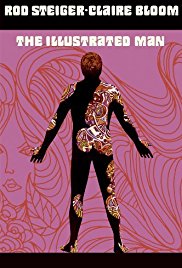The Illustrated Man ** (1969, Rod Steiger, Claire Bloom, Robert Drivas) – Classic Movie Review 6848
As 1930s psychotic drifter Carl, Rod Steiger is tattooed from neck to foot for director Jack Smight’s offbeat and fascinating 1969 film from a book by Ray Bradbury.
Each of his tattoos tells a disturbing story and Carl shows three of them to a mesmerised traveller in stories (The Veldt, The Long Rain and The Last Night of the World) acted out by the same cast.
Alas, uncertainties abound in Howard B Kreitsek’s screenplay and Smight’s handling, but there are plenty of visual surprises in cinematographer Philip H Lathrop’s widescreen images and watchable performances.
Commendably ambitious and arty, The Illustrated Man is a brave try by unusually talented and hard-working professionals, and is in the interesting category, but it is not really a success – and certainly never a popular movie.
Also in the cast are Claire Bloom, Robert Drivas, Don Dubbins, Jason Evers, Tim Weldon and Christine Matchett.
Obviously the make-up is a crucial item and the make-up director Gordon Bau and his eight assistants spent ten hours applying the temporary tattoos to Steiger’s torso, plus another day tattooing his hands, legs and lower body.
The Illustrated Man is directed by Jack Smight, runs 103 minutes, is produced by SKM, is released by Warner Bros, is written by Howard B Kreitsek, is shot in widescreen and Technicolor by Philip H Lathrop, is produced by Howard B Kreitsek and Ted Mann, is scored by Jerry Goldsmith and designed by Joel Schiller.
The Bradbury novel is a classic collection of 18 startling vision stories of humankind’s destiny, etched on the tattooed body of The Illustrated Man.
The wild animals are credited as ‘affection-trained at Africa, U.S.A.’
Steiger and Bloom were married from 19 September 1959 to 10 June 1969 (divorced, with one daughter, the opera singer Anna Steiger).
© Derek Winnert 2018 Classic Movie Review 6848
Check out more reviews on http://derekwinnert.com



